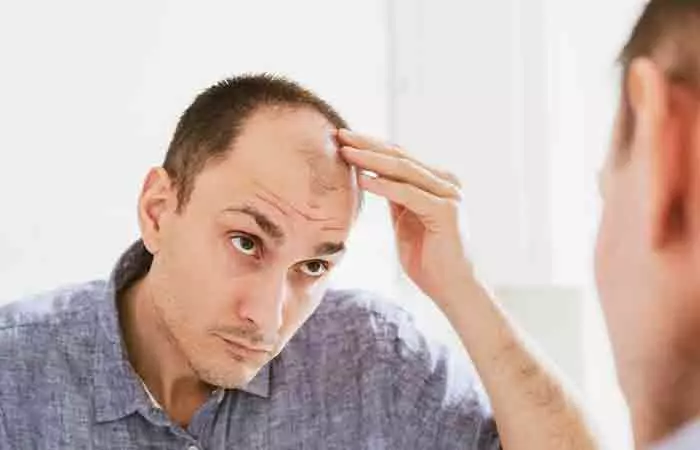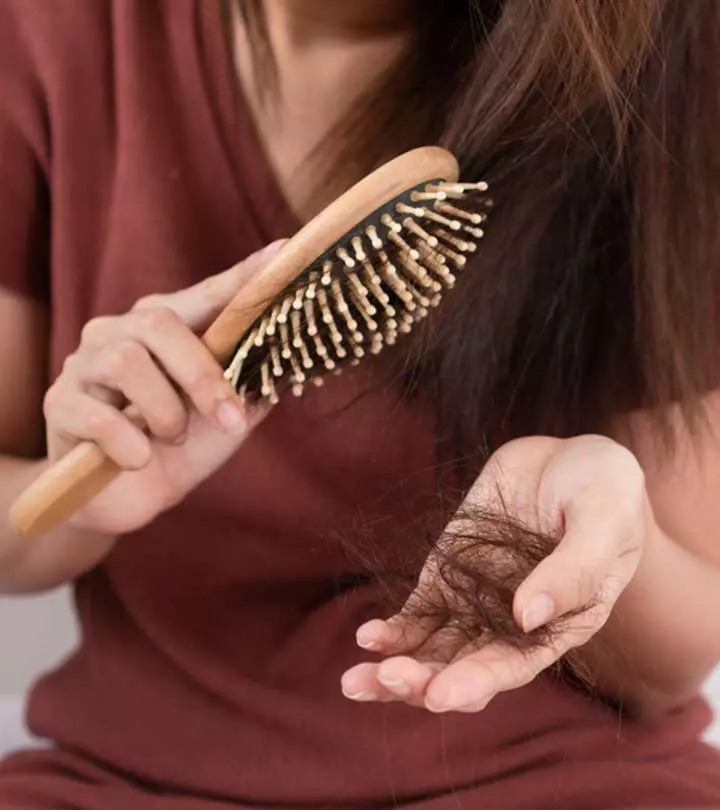Genetic Hair Loss: Causes, Symptoms, And 2 Proven Treatments
Look out for a receding hairline and hair thinning if you have a family history of baldness.

Image: Shutterstock
Androgenic alopecia is a form of hereditary or genetic hair loss that causes a degree of balding both in men and women.
An estimated 80 million people are affected by androgenic alopecia in the United States alone (1). In this genetically predetermined condition, the genes can determine the onset of balding. The growth phase of hair slows down and the hair follicle shrinks, causing hair follicle miniaturization. This can ultimately lead to hair shedding and produces shorter and finer hairs, leading to hair loss. Keep reading to understand the link between genetics and hair loss, its symptoms, and when you should see a doctor.
In This Article
Genetic Hair Loss: What Science Says

Hair loss is distressing to deal with. You may have heard that if one of your parents or grandparents is bald, then there is a chance that you may go bald too. But, is it true? If it is true, then what is the link between heredity and hair loss? Let’s check out the scientific proof.
You can observe hereditary hair loss in both men and women, which are known as male pattern baldness and female pattern baldness. Hair loss tendency on both sides of the family is responsible for genetic hair loss, and it accounts for nearly 80% of this condition (2).
A cohort study conducted between January 2016 and December 2019, involving 18,368 participants, aimed to determine the annual prevalence and incidence of Alopecia Areata (AA) and Alopecia Totalis/Universalis (AT/AU) in the United States. The study revealed that the prevalence increased from 0.199% to 0.222% over the period. It was also found that females were more likely than males to experience the prevalence and incidence of Alopecia areata.

- Male Pattern Baldness

Male pattern baldness (MPB) often starts at the age of 20 or 30 as an M-shaped recession of the hair at the front of the scalp. Male pattern baldness affects 80% of men by the age of 80 (3). How quickly or slowly baldness develops is determined by the genes that you inherit from your parents. A study conducted at the Wright State University School of Medicine (USA) found that the probability of hair loss in males is dependent on family history and age (4). Though the genetic component responsible for male pattern baldness is not well understood, it is believed that it involves more than one gene (5).
Humans have 23 pairs of chromosomes in which all the genetic information is stored. One of these sets of chromosomes are comprised of X and Y chromosomes, which determine your gender. Babies inherit characteristics from their parents through these chromosomes. Baldness is closely associated with the androgen receptor (AR) gene found on the X chromosome (4). Men inherit this X chromosome from their mother (6). Men with AR genes have been found to have a tendency to develop male pattern baldness or androgenetic alopecia more than people without it (7).
Fact: It is estimated that humans have between 20,000 to 25,000 genes in their bodies (8).
Are only AR genes responsible for genetic hair loss out of the thousands of genes in the human body? No, research has also found that along with the AR gene, 63 more genes may play a key role in male pattern baldness (9). However, more research is required to understand male pattern baldness and the genes responsible for it.
- Female Pattern Baldness

In females, hair loss is gradual, and it can occur after the menopause stage, but some women may experience it sooner. Approximately 40% of women experience hair loss by the age of 50 and 55% of women by the age of 80 (10). When compared with male pattern baldness, female pattern hair loss may be less obvious as it presents in a different way to men. The gene responsible for this still remains unknown (11). It is believed that, like MPB, it also involves multiple genes. Generally, at least a quarter of all women experience some degree of hair thinning by the age of 50. Also, you can observe finer hair with less color at this stage.
Along with hair loss, you can also inherit sensitivity to one of the male sex hormones, DHT (dihydrotestosterone). DHT causes your hair follicles to shrink, which then leads to baldness (12). At puberty, testosterone starts circulating in the body if you are genetically predisposed to testosterone sensitivity. Unfortunately, this pattern is set. Testosterone binds to the AR receptor in the follicle with an enzyme called 5-alpha reductase (5AR). This converts the testosterone into the more potent dihydrotestosterone. This results in the follicles becoming miniaturized, creating shorter and finer hairs with each successive shortened anagen phase.
You may notice progressive thinning hair or balding if you have hereditary hair loss. But, is it the same in both males and females? Find out more in the following section.
Key Takeaways
- Androgenic alopecia is a form of hereditary or genetic hair loss that causes the hair growth cycle to slow down, the hair follicles to shrink and ultimately lead to male pattern or female pattern baldness.
- Male pattern baldness generally starts at the age of 20 or 30 as an M-shaped recession of the hair at the front of the scalp whereas female pattern hair loss may be less obvious and generally begins after menopause, but not exclusively.
- There is no cure for genetic hair loss, but certain medications like minoxidil and finasteride may help to slow down hair thinning.
Symptoms Of Genetic Hair Loss

In males, you can observe progressive thinning of hair, which starts with a receding hairline. This condition then leads to a bald spot at the crown area of your head. In the advanced stages of hair thinning, you may notice a rim of hair along the back of the head.
In females, you rarely observe bald patches. But, you may notice thinning of hair at the top of the head. For women, the temples and forehead areas are not usually affected. Most women report a widening of their parting, which shows more scalp.
You may observe thinning of hair as you age. But, if you notice it early in your life due to hereditary factors, can you reverse it? Find out in the next section.
Can You Reverse Genetic Hair Loss?

You cannot cure genetic hair loss. But, there are some options to slow down hair loss. Certain medications are prescribed by doctors to slow hair thinning, and you have to be extremely disciplined when taking them. These medications include:
- Minoxidil: Minoxidil is an over-the-counter medication for hair thinning. It is more effective at the early stages of hair loss (13), (14). It is also known as Rogaine, and you should apply it twice a day to your scalp. It enhances blood circulation in the affected area of the scalp and strengthens the hair follicles. It can be used by both men and women, but higher concentrations work best for men. Also, once this treatment starts, it needs to be continued for at least six months.
- Finasteride: Finasteride is a prescription-only pill for hereditary hair loss treatment. This FDA-approved pill works by preventing testosterone from getting converted into DHT (a hormone that shrinks hair follicles) (15), (16). You need to take this pill once daily for at least six months to treat DHT hair loss. Also, it is only recommended for men.
 Quick Tip
Quick TipThough genetic hair loss is normal, you should consult your doctor in case of sudden hair loss. Find out why in the next section.
When Should You See A Doctor?
Hereditary or genetic hair loss is natural. But, there could also be an underlying health condition causing your hair loss. If you observe sudden and patchy hair loss, scarring, flaking, redness, or hair falling out more than normal before your 30s, then you should consult a doctor.
Nijiati Abulizi, a blogger, recounts experiencing sudden hair loss in his late twenties, leading to a decline in confidence and self-esteem. A doctor diagnosed him with androgenic alopecia, offering two options: embrace the change or use Finasteride [medication]. He recounts, “I decided to do my own research and reverse my hair loss. I had to convince my doctor to do a complete blood test to find out I had an ongoing H. Pylori infection in my stomach. Then I was treated for it. I also worked hard to resolve the inflammation in my body caused by this bug. Lo and behold, after a few months my hair started to grow back (i).”
There are a few popular myths about baldness and hereditary hair loss. Learn more about them in the next section.
Myths Associated With Genetic Hair Loss
Myth 1:
Genetic Hair Loss Only Happens To Men
Hair loss in women is pretty common too. In fact, it is estimated that nearly 30 million women in the United States alone experience female pattern baldness (1). They also experience more hair thinning, usually at the parting. The hair loss in women just presents differently from men.
Myth 2: Physical Activities Like Weight Training Cause Baldness
Although many studies do prove that physical activities enhance testosterone levels, there is no direct evidence that confirms a link between exercise and hair loss. It is believed that men with high testosterone levels have higher chances of male pattern baldness. However, it is important that this hair loss only occurs in men and women who are predisposed to testosterone sensitivity.
Myth 3: Baldness Is Caused By Sleep Deprivation, Stress, or Styling Options
Stress, super-tight hairstyles, and sleep deprivation can cause hair loss, but it is totally different from genetic hair loss. However, the link between these factors and hair loss are not well established.
Myth 4: Baldness skips a generation
While it may seem like baldness skips a generation, it is necessary to understand that hair loss patterns are complex and can be influenced by multiple genes. Androgenetic alopecia is typically hereditary and can be inherited from both sides of the family. In some cases, it may appear to skip a generation due to the presence of different genetic factors at play. Some individuals may carry the genetic predisposition for hair loss without displaying noticeable signs until a later age. Additionally, a range of factors, including hormonal changes, can influence genetic expression. While there is a genetic component to baldness, it does not strictly adhere to a predictable generational pattern. Hence, making predictions about hair loss patterns is challenging.
 Quick Tip
Quick TipInfographic: Common Misconceptions About Genetic Hair Loss
Genetic hair loss is a subject steeped in misconception. While the article above cuts through the dense web of misinformation and reveals the truth, there are a few myths we???d like to focus on. Check out the infographic given below to get the right facts on hair loss.
Some thing wrong with infographic shortcode. please verify shortcode syntaxConclusion
Genetic hair loss affects both men and women. Androgenic alopecia, a hereditary hair loss, is majorly seen in the United States. The common signs of genetic hair loss include progressive thinning of the hair, receding hairline, and thinning of the hair at the top of the head. Using over-the-counter medications like minoxidil, or Finasteride, a prescription-only pill, helps combat genetic hair loss. However, hereditary hair loss is permanent and cannot be reversed completely. However, with these medications, you can slow down the process of hair thinning.
Frequently Asked Questions
Are there any natural remedies for genetic hair loss?
You cannot completely cure genetic hair loss. But, there are some options to slow down hair loss, including home remedies, such as essential oils like rosemary oil. A recent study showed positive results of rosemary oil in boosting hair growth and being a successful alternative to minoxidil in the treatment of androgenic alopecia (17). However, it is crucial that you talk to your doctor before incorporating any remedies for genetic hair loss.
Is hair loss completely genetic?
No. Stress, nutrition, lifestyle, underlying medical conditions, and environmental factors can also trigger hair loss.
At what age does genetic hair loss start?
Genetic hair loss generally begins around the late 20s or early 30s.
Is hair loss genetic from mother or father?
Yes. Hair loss can be genetic and passed down from either parent (18).
Explore the role of genetics in hair loss. Watch this video to understand how genetics can impact your hair growth and lead to baldness. Check it out!
Personal Experience: Source
StyleCraze's articles are interwoven with authentic personal narratives that provide depth and resonance to our content. Below are the sources of the personal accounts referenced in this article.
i. I reversed my hair loss. But I had to fight for it.https://nijat.medium.com/i-reversed-my-hair-loss-but-i-had-to-fight-for-it-3a7ab827d7f4
References
Articles on StyleCraze are backed by verified information from peer-reviewed and academic research papers, reputed organizations, research institutions, and medical associations to ensure accuracy and relevance. Read our editorial policy to learn more.
- SKIN CONDITIONS BY THE NUMBERS,
https://www.aad.org/media/stats-numbers - Male Androgenetic Alopecia,
https://www.ncbi.nlm.nih.gov/books/NBK278957/ - Family history and risk of hair loss,
https://pubmed.ncbi.nlm.nih.gov/15237265/ - Genetic prediction of male pattern baldness,
https://www.ncbi.nlm.nih.gov/pmc/articles/PMC5308812/ - Dissection of genetic variation and evidence for pleiotropy in male pattern baldness,
https://www.ncbi.nlm.nih.gov/pmc/articles/PMC6302097/ - INHERITANCE PATTERNS,
https://www.ncbi.nlm.nih.gov/books/NBK115561/ - Six Novel Susceptibility Loci for Early-Onset Androgenetic Alopecia and Their Unexpected Association with Common Diseases,
https://www.ncbi.nlm.nih.gov/pmc/articles/PMC3364959/ - What is a gene?,
https://medlineplus.gov/genetics/understanding/basics/gene/ - Meta-analysis identifies novel risk loci and yields systematic insights into the biology of male-pattern baldness,
https://pubmed.ncbi.nlm.nih.gov/28272467/ - Female Pattern Hair Loss: A Retrospective Study in a Tertiary Referral Center,
https://www.ncbi.nlm.nih.gov/pmc/articles/PMC4989388/ - Genetics and other factors in the aetiology of female pattern hair loss,
https://pubmed.ncbi.nlm.nih.gov/28453904/ - Cause of Androgenic Alopecia: Crux of the Matter,
https://www.ncbi.nlm.nih.gov/pmc/articles/PMC4174066/ - Minoxidil,
https://www.ncbi.nlm.nih.gov/books/NBK482378/ - Minoxidil and its use in hair disorders: a review,
https://www.ncbi.nlm.nih.gov/pmc/articles/PMC6691938/ - Finasteride in the treatment of men with androgenetic alopecia. Finasteride Male Pattern Hair Loss Study Group,
https://pubmed.ncbi.nlm.nih.gov/9777765/ - Finasteride: a review of its use in male pattern hair loss,
https://pubmed.ncbi.nlm.nih.gov/9951956/ - The Use of Natural Ingredients in the Treatment of Alopecias with an Emphasis on Central Centrifugal Cicatricial Alopecia: A Systematic Review
https://pmc.ncbi.nlm.nih.gov/articles/PMC7595365/ - The role of family history and its influence on the onset time in female pattern hair loss
https://www.ncbi.nlm.nih.gov/pmc/articles/PMC8610059/
Read full bio of Dawn Hilton
Read full bio of Arshiya Syeda
Read full bio of Ramona Sinha
Read full bio of Medha Deb



























Community Experiences
Join the conversation and become a part of our empowering community! Share your stories, experiences, and insights to connect with other beauty, lifestyle, and health enthusiasts.